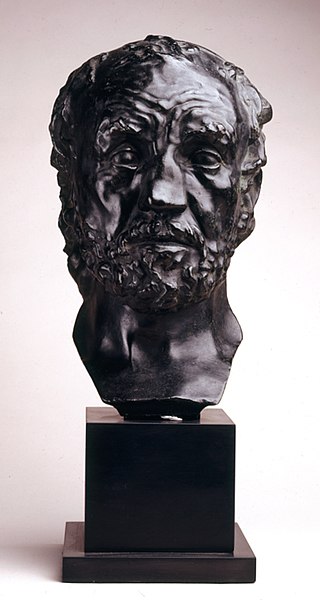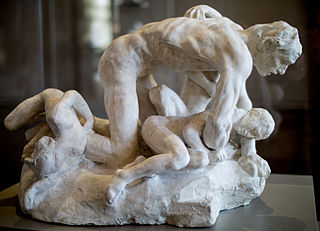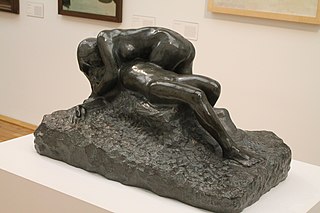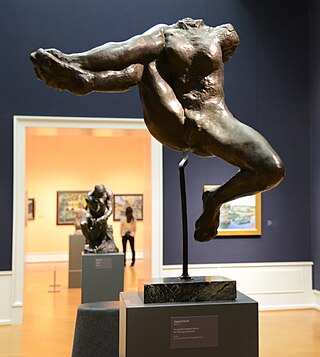
François Auguste René Rodin was a French sculptor generally considered the founder of modern sculpture. He was schooled traditionally and took a craftsman-like approach to his work. Rodin possessed a unique ability to model a complex, turbulent, and deeply pocketed surface in clay. He is known for such sculptures as The Thinker, Monument to Balzac, The Kiss, The Burghers of Calais, and The Gates of Hell.

Camille Rosalie Claudel was a French sculptor known for her figurative works in bronze and marble. She died in relative obscurity, but later gained recognition for the originality and quality of her work. The subject of several biographies and films, Claudel is well known for her sculptures including The Waltz and The Mature Age.

The Thinker is a bronze sculpture by Auguste Rodin, situated atop a stone pedestal. The work depicts a nude male figure of heroic size sitting on a rock. He is seen leaning over, his right elbow placed on his left thigh, holding the weight of his chin on the back of his right hand. The pose is one of deep thought and contemplation, and the statue is often used as an image to represent philosophy.

The Kiss is an 1882 marble sculpture by the French sculptor Auguste Rodin.

The Gates of Hell is a monumental bronze sculptural group work by French artist Auguste Rodin that depicts a scene from the Inferno, the first section of Dante Alighieri's Divine Comedy. It stands at 6 metres high, 4 metres wide and 1 metre deep (19.7×13.1×3.3 ft) and contains 180 figures.

Jessie Lipscomb, later Jessie Elborne, was an English sculptor of the human figure. She worked in Paris in a shared studio workshop in the late 1800s with French sculptor Camille Claudel and two fellow alumni from the Royal College of Art: Amy Singer and Emily Fawcett.

Eugène Anatole Carrière was a French Symbolist artist of the fin-de-siècle period. Carrière's paintings are best known for their near-monochrome brown palette and their ethereal, dreamlike quality. He was a close friend of Auguste Rodin and his work likely influenced Pablo Picasso's Blue Period. He was also associated with such writers as Paul Verlaine, Stéphane Mallarmé and Charles Morice.

Monument to Balzac is a sculpture by Auguste Rodin in memory of the French novelist Honoré de Balzac. According to Rodin, the sculpture aims to portray the writer's persona rather than a physical likeness. The work was commissioned in 1891 by the Société des Gens de Lettres and a full-size plaster model was displayed in 1898 at a Salon in Champ de Mars. After coming under criticism the model was rejected by the société and Rodin moved it to his home in Meudon. On 2 July 1939 the model was cast in bronze for the first time and placed on the Boulevard du Montparnasse at the intersection with Boulevard Raspail.

The Mature Age, also named Destiny, The Path of Life or Fatality (1894–1900) is a sculpture by French artist Camille Claudel. The work was commissioned by the French government in 1895, but the commission was cancelled in 1899 before a bronze was cast. A plaster version of the sculpture was exhibited in 1899, and then cast in bronze privately in 1902. A second private bronze casting was made in 1913, and it is thought that the plaster version was destroyed at that time.

Cybele is a sculpture by French artist Auguste Rodin. It is one of the first of Rodin's partial figures known as "fragments" to be displayed as sculpture in its own right, rather than an incomplete study.

Man with the Broken Nose is a sculpture by Auguste Rodin created between 1863 and 1864 and approved by the Salon in 1875. It is considered the first by Rodin in which life is represented over the grace pervading the academic circles and aesthetic of the time.

Pierre de Wissant is a bronze sculpture by French artist Auguste Rodin, part of his sculptural group The Burghers of Calais. This sculpture represents one of the six burghers who, according to Jean Froissart surrendered themselves in 1347, at the beginning of the Hundred Years' War (1337–1453), in order to save the inhabitants of the French city of Calais from the English laying siege to the city.

Ugolino and his sons is a plaster sculpture by French artist Auguste Rodin, part of the sculptural group known as The Gates of Hell. As an independent piece, it was exhibited by its author in Brussels (1887), Edinburgh (1893), Genoa (1896), Florence (1897), Netherlands (1899) and in his own retrospective in 1900.

Aline Victorine Charigot was a model for Auguste Renoir and later became his wife while continuing to model for him and then caring for him when he became disabled. She is pictured in many of his paintings over very many years, most famously in the early 1880s Luncheon of the Boating Party, and Blonde Bather. They had three children together, two of whom, Pierre and Jean, went on to have distinguished careers in film, and the third, Claude, became a ceramic artist. Pierre had a son Claude who became the well-known cinematographer. She predeceased her elderly husband.

The Old Tree is a plaster sculpture by the French artist Auguste Rodin, originally conceived as part of his The Gates of Hell project.

Young Mother is a bronze sculpture by Auguste Rodin with a brown and green patina, conceived in 1885 and cast by the Rudier Foundry.

The Death of Adonis is a white marble sculpture. It was created by Auguste Rodin and signed “A RODIN” on the base. It shows Aphrodite mourning over the body of Adonis. The main version is in the Musée Rodin and another is in the Museo Soumaya.

Sakuntala, also known as Sakountala or Çacountala, is a sculpture by the French artist Camille Claudel, made in several versions in different media from 1886, with a marble version completed in 1905, and bronze castings made from 1905. The sculpture depicts a young couple, with a kneeling man embracing a woman leaning towards him. It was named after the play Shakuntala by the 4th-5th century Indian poet Kālidāsa, and is inspired by the moment when the title character Shakuntala is reunited with her husband Dushyanta after a long separation.

Iris, Messenger of the Gods is a bronze sculpture by Auguste Rodin. A plaster model, created between 1891 and 1894, was cast in bronze by Fonderie Rudier at various times from about 1895. Iris is depicted with her right hand clasping her right foot and her naked body posed provocatively with her legs spread wide, displaying her genitalia.



















